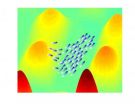(Press-News.org) Stocks of Atlantic salmon (Salmo salar), which have been steadily declining for the past few decades, are facing new challenges in the Gulf of Maine, where changing spring wind patterns, warming sea surface temperatures and new predators along altered migration routes are affecting their survival.
In a paper published online in the journal Fisheries Management and Ecology, Kevin Friedland and co-authors suggest post-smolts are entering an increasingly warmer coastal ocean, where they are facing mortality risks associated with a changing climate, such as changing distributions of potential predators. They also suggest Gulf of Maine salmon survival during their first months at sea is related to predation, possibly by populations of silver hake, red hake and spiny dogfish increasingly found along the salmon's extended migration routes in the western Gulf of Maine. Friedland is a researcher at the Narragansett Laboratory of NOAA's Northeast Fisheries Science Center, and is a member of the Center's Ecosystems Assessment Program.
Gulf of Maine Atlantic salmon are listed as endangered, and returns of these fish to rivers where they spawn have been low despite increased numbers of smolts entering the marine environment. The researchers examined a variety of data collected over decades, including spring wind patterns, Gulf of Maine currents, ocean circulation systems, historical tagging returns, migratory routes, and changes in potential predator abundances and distribution patterns. Models were used to consider how shifting climate and biological factors, under various scenarios, affected salmon recruitment and survival in the Gulf of Maine.
"This study had two primary goals. The first was to examine the effects of spring winds in the Gulf of Maine on the migration trajectory of post-smolts, since the route and length of migration could impact their mortality or survival," said Friedland. "The second goal was to look at the spatial distribution and abundance of a number of potential predators, since increased predation along the post-smolts migratory routes could result in increased mortality."
Atlantic salmon are anadromous fish, meaning they are born in fresh water and migrate from rivers to the ocean after undergoing a number of distinct stages of development over several years. As smolts, the thin silver fish head to the ocean, usually between March and June, to begin a stage of enhanced feeding and growth. After several years at sea, adults return to the freshwater streams and rivers where they were born to reproduce.
At one time Atlantic salmon could be found in rivers throughout much of New England, but Maine is now the only state in the region with wild Atlantic salmon populations. While increasing numbers of smolts are entering the ocean via the Gulf of Maine, few are returning, raising questions as to where these fish are going and what is happening to them at sea.
"Shifting environmental conditions affect both the freshwater and marine habitats for Atlantic salmon, and are already a concern for salmon stocks at the southern end of their distribution range in both North America and Europe, "Friedland said. "Understanding the linkages between post-smolt survival and climate, especially ocean conditions, is critical and needs to be considered in the scientific basis for conservation planning and management actions."
Rising temperatures could exceed the tolerable limits for juvenile salmon and reduce the amount of habitat available for growth and development during their freshwater stages. Warming ocean temperatures in the Gulf of Maine, expected to occur in the decades ahead, could result in extirpation of salmon stocks from the southern end of the species' range.
###
In addition to lead author Kevin Friedland, study authors included James Manning and Jason Link from the NEFSC's Woods Hole Laboratory; James Gilbert from the University of Maine, Orono; and Andrew Gilbert and Allan O'Connell, Jr. from the U.S. Geological Survey's Patuxent Wildlife Research Center.
Environmental conditions and predators affect Atlantic salmon survival in the Gulf of Maine
2011-11-21
ELSE PRESS RELEASES FROM THIS DATE:
Researchers discover new way to form extracellular vesicles
2011-11-21
Researchers at NYU Langone Medical Center have discovered a protein called TAT-5 that affects the production of extracellular vesicles, small sacs of membrane released from the surface of cells, capable of sending signals to other cells. When released extracellular vesicles can affect tumor spread, blood clotting and inflammation. Their discovery gives new insight into how extracellular vesicles form, and reveals new potential strategies to manipulate diseases such as cancer. The study was published online November 17, 2011 in Current Biology.
"Very little is known ...
Micro-cavity arrays: Lighting the way to the future
2011-11-21
It was not too long ago that basic science lectures began with the three forms of matter: gases, liquids and solids—and somewhere along the line plasmas were occasionally added to the list. But to be precise, a plasma is an ionized gas; thus, a subset of the big three. But this subset has coexisted with the other forms since the Big Bang and actually makes up 99 percent of the universe. It is found in our Sun and all the other stars, and in more down to earth applications: in neon signs, Plasma TVs, Cathode Ray Tubes, and the ubiquitous fluorescent light.
It is now ...
Bleak future for Bay area tidal marshes?
2011-11-21
[San Francisco, CA] – A new study, led by PRBO Conservation Science (PRBO), projects a bleak future for San Francisco Bay's tidal marshes under high-end sea-level rise scenarios that are increasingly likely. PRBO and colleagues found that in the worst case scenario 93% of San Francisco Bay's tidal marsh could be lost in the next 50-100 years [with 5.4 feet or 1.65 meters of sea-level rise, low sediment availability and no significant restoration].
PRBO's study indicates, however, that not all marshes will be lost and that society's actions today, including restoration ...
Smart swarms of bacteria inspire robotics researchers
2011-11-21
Much to humans' chagrin, bacteria have superior survival skills. Their decision-making processes and collective behaviors allow them to thrive and even spread efficiently in difficult environments.
Now researchers at Tel Aviv University have developed a computational model that better explains how bacteria move in a swarm — and this model can be applied to man-made technologies, including computers, artificial intelligence, and robotics. Ph.D. student Adi Shklarsh — with her supervisor Prof. Eshel Ben-Jacob of TAU's Sackler School of Physics and Astronomy, Gil Ariel ...
Targeting bacterial gas defenses allow for increased efficacy of numerous antibiotics
2011-11-21
Although scientists have known for centuries that many bacteria produce hydrogen sulfide (H2S) it was thought to be simply a toxic by-product of cellular activity. Now, researchers at NYU School of Medicine have discovered H2S in fact plays a major role in protecting bacteria from the effects of numerous different antibiotics.
In the study led by Evgeny Nudler, PhD, the Julie Wilson Anderson Professor of Biochemistry at NYU School of Medicine, researchers found evidence that H2S acts as a general defense mechanism against oxidative stress, the process through which ...
NASA's Chandra adds to black hole birth announcement
2011-11-21
New details about the birth of a famous black hole that took place millions of years ago have been uncovered, thanks to a team of scientists who used data from NASA's Chandra X-ray Observatory as well as from radio, optical and other X-ray telescopes.
Over three decades ago, Stephen Hawking placed -- and eventually lost – a bet against the existence of a black hole in Cygnus X-1. Today, astronomers are confident the Cygnus X-1 system contains a black hole, and with these latest studies they have remarkably precise values of its mass, spin, and distance from Earth. With ...
VLBA observations key to 'complete description' of black hole
2011-11-21
For the first time, astronomers have produced a complete description of a black hole, a concentration of mass so dense that not even light can escape its powerful gravitational pull. Their precise measurements have allowed them to reconstruct the history of the object from its birth some six million years ago.
Using several telescopes, both ground-based and in orbit, the scientists unravelled longstanding mysteries about the object called Cygnus X-1, a famous binary-star system discovered to be strongly emitting X-rays nearly a half-century ago. The system consists of ...
Study of flower petals shows evolution at the cellular level
2011-11-21
A new study of flower petals shows evolution in action, and contradicts more that 60 years of scientific thought.
The findings are reported by a scientist from UC Santa Barbara and a research team from Harvard University in the Proceedings of the Royal Society B this week.
Columbine flowers, known as Aquilegia, evolved several lengths of petal spurs that match the tongue lengths of their pollinators, including bees, hummingbirds, and hawkmoths. The petal spurs are shaped like a tubular pocket and contain nectar at the tip. The spurs grow from 1 to 16 centimeters in ...
Molecules on branched-polymer surfaces can capture rare tumor cells in blood
2011-11-21
The removal of rare tumor cells circulating in the blood might be possible with the use of biomolecules bound to dendrimers, highly branched synthetic polymers, which could efficiently sift and capture the diseased cells, according to new research at the University of Illinois at Chicago.
Dendrimers have been used to encapsulate drug molecules and serve as a delivery vehicle, but in the new study they were employed to capture circulating tumor cells by biomimicry -- using nanotechnology to create artificial surfaces much like those in real cells.
"We want to take advantage ...
US preterm birth rate under 12 percent, the lowest level in nearly a decade
2011-11-21
WHITE PLAINS, N.Y., Nov. 17, 2011 – The nation's preterm birth rate slipped under 12 percent for the first time in nearly a decade, the fourth consecutive year it declined, potentially sparing tens of thousands of babies the serious health consequences of an early birth.
The national preterm birth rate declined to 11.99 percent last year, according to the National Center for Health Statistics, which released its report "Births: Preliminary Data for 2010," today, the first-ever World Prematurity Day. Despite the improvement, still too many babies, one out of every eight, ...



